Exhibitions, Projects

Voices from AI in Experimental Improvisation
Tomomi Adachi (JP), Andreas Dzialocha (DE), Marcello Lussana (IT)
Through machine learning, computers can recognize patterns in a variety of sound documents. But can they also learn to improvise musically? The software “Tomomibot” tries it out by interacting in real time with the sound artist Tomomi Adachi, using deep learning techniques. The Artificial Intelligence (AI) "learns" the artist’s individual style via voice recordings and directly confronts him with the newly generated material. Their joint performance shows how interactive technology and AI can influence a (vocal) style. However, this dialogue also makes clear that the artist will always be more creative and unpredictable than his mechanical counterpart.

Seeing I
Mark Farid (UK)
For 24 hours a day, for 28 days, artist Mark Farid will wear a virtual reality headset, seeing and hearing what one person sees and hears for 28 days.

What a Ghost Dreams Of
h.o (INT)
What is a “ghost”? Generally it is understood as an inner “soul” and a mysterious outward appearance. What a Ghost Dreams Of grapples with a new “ghost” of our time: digital surveillance in our society.
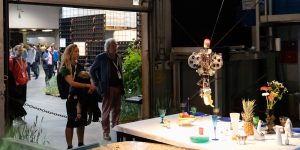
UngenauBot
Ilmar Hurkxkens (NL), Fabian Bircher (CH)
UngenauBot combines highly developed robot technology with an everyday rubber glove performing banal activities. By deliberately exploiting empirical errors in robotic systems and artificial intelligence, this work demonstrates the limits of technology when things don’t go according to plan.

Teletext Hackathon
Nadine Arbeiter (DE), Cordula Ditz (DE), Daniel Egg (AT), Dan Farrimond (UK), Juha van Ingen (FI), Joey Holder (UK), Kathrin Günter (DE), Raquel Meyers (ES), Matthias Moos (CH), Niccolò Moronato (IT), Jarkko Räsänen (FI), Seppo Renvall (FI) and UBERMORGEN (AT/CH/USA)
At the Teletext Hackathon in the POSTCITY, five of the participating artists will create live teletext art, and the public is also cordially invited to get creative on site with teletext software. The resulting artworks can immediately be published and admired in ORF TELETEXT. The teletext exhibition ORF TELETEXT meets art will be shown in a presentation at Deep Space.
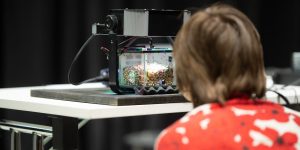
^lgorithmZoo Pt. 5. : KTV Session
Rico Graupner (DE)
^lgorithm Zoo pt. 5 "KtV Sessions Vol II. is a concert series that deals with the sonic fusion of different biological habitats. In this case, a beetle-controlled synthesizer interacts with the sound installation ZoomBx. The movement events of the insects are tracked by a specially developed software (IcCE) that makes it possible to map the acquired data to musical parameters as well as different positions in space.
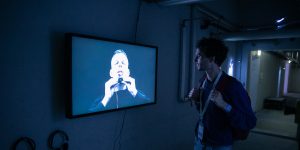
Simulation
Jörg Brinkmann (DE)
The sound of a voice from a YouTube clip is analyzed with custom software and translated into servomotor movements. The mouth moves in synch with the video’s voice, which is realized with a bulldog clip that is attached to the lower lip. In the original video clip, a controversial and much-discussed shaman known as Little Grandmother delivers a monologue about religion, ego, and love reminiscent of a mantra.

Inter Faces
Régis Costa de Oliveira (BR)
The Inter Faces performance uses augmented reality to replace the performer's body – including self-portraits – with digital images framed on a screen. The performers will act in a space that fuses the real with the digital. Their actions will likewise occur by crossing in between these two worlds, exploring simulacra and making it evident it from digital contents that seemingly appeal to us, even as it also makes clear how such temptations can exert a narcoticizing, hallucinogenic effect on us.
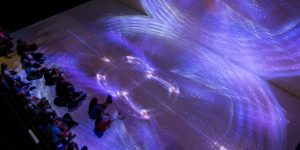
Singing Sand 2.0
Tadej Droljc (SI)
Singing Sand 2.0 is the newest iteration of Tadej Droljc’s experimentations with abstract stereographic 3D computer graphics, rendered in 8K for the first time. The piece is an immersive, audiovisual experiment in which the movement of particles is sonified in real-time, affecting the color- and soundscape that envelopes the audience.
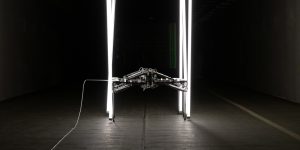
CRYPTID
Michael Candy (AU)
A monumental robotic light sculpture, CRYPTID exists as a vibrant anomaly in contrast to contemporary automata, sharing a presence both radiant and reserved.


